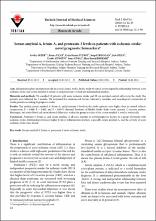Serum amyloid A, fetuin-A, and pentraxin-3 levels in patients with ischemic stroke: Novel prognostic biomarkers?

View/
Access
info:eu-repo/semantics/openAccessDate
2014Author
Sezer, SevilayUçar, Fatma
Ulusoy, Ersin Kasım
Erdoğan, Serpil
Bilen, Şule
Züngün, Cevdet
Uysal, Sema
Erdemli, Hacı Kemal
Metadata
Show full item recordCitation
Sezer, S., Uçar, F., Ulusoy, E. K., Erdoğan, S., Bilen, Ş., Züngün, C., Uysal, S., Erdemli, H. K. (2014). Serum amyloid A, fetuin-A, and pentraxin-3 levels in patients with ischemic stroke: novel prognostic biomarkers?. Turkish Journal of Medical Sciences, 44(1), 16-23.Abstract
Aim: Inflammation plays an important role in acute ischemic stroke. In this study we aimed to investigate the relationship between acute ischemic stroke and serum amyloid A, fetuin-A, and pentraxin-3 which are inflammation markers. Materials and methods: We enrolled 52 patients with acute ischemic stroke and 30 sex-matched control subjects in the study. The patients were followed for 3 months. We evaluated the common risk factors, laboratory variables, and neurological examination of stroke patients according to prognosis scales. Results: The median serum amyloid A, fetuin-A, and pentraxin-3 levels in the stroke patients were higher than in control subjects (respectively, P = 0.000, P = 0.002, and P = 0.037). National Institutes of Health Stroke Scale scores, glucose, C-reactive protein, fibrinogen, and white blood cell count showed differences within the group in terms of the serum amyloid A tertiles statistically. Conclusion: Pentraxin-3, fetuin-A, and serum amyloid A all arise together as novel prognostic factors in a group of patients with ischemic stroke. Relationships between higher levels of inflammation markers, especially serum amyloid A, and the severity of acute ischemic stroke were shown. © TÜBİTAK.

















